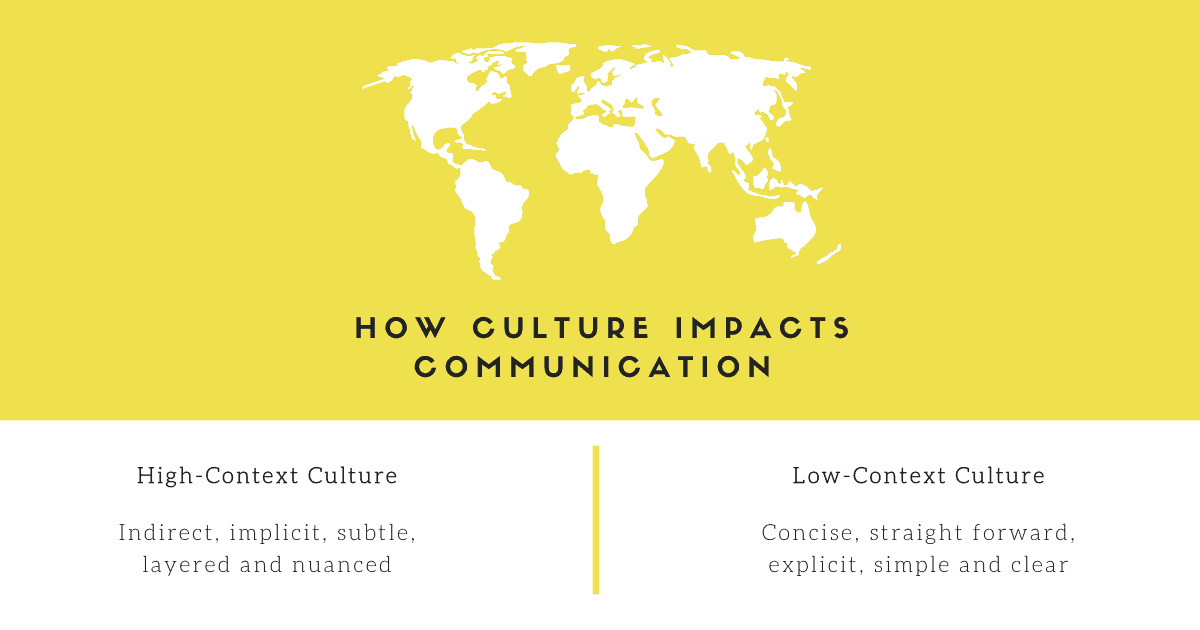High-context Cultures Rely More on Nonverbal Cues
High-context cultures rely more on nonverbal cues than do low-context cultures. B people rely less on the environmental setting to convey meaning.

High Context And Low Context Cultures Wikiwand
B In high-context cultures people rely heavily on nonverbal and subtle situational cues in communicating with others and a persons official status place in society and reputation carry considerable weight.
. High-context cultures rely less on nonverbal cues than do low-context cultures. D aggressive negotiation is. A people rely more on nonverbal circumstances and cues to convey meaning.
People rely more on nonverbal circumstances and cues to convey meaning. Rely heavily on nonverbal and subtle situational cues in communication o Low-context cultures. High context cultures rely more on nonverbal cues than do low context cultures false collectivistic cultures tend to place a high value on self reliance and competition.
The rules of everyday life are highly explicit. Rely heavily on words to convey meaning in communication CHAPTER 9 CONFLICT AND NEGOTIATION Conflict Demand. C the rules of everyday life are highly explicit.
11 In high-context cultures A people rely more on nonverbal circumstances and cues to convey meaning. High-context cultures differ from low-context cultures because they. This question was created from Exam 1docx.
B people rely less on the environmental setting to convey meaning. B people rely less on the environmental setting to convey meaning. People rely less on the environmental setting to convey meaning C.
D aggressive negotiation is expected. High-context cultures rely more on nonverbal cues than do low-context cultures. A lot of cultural traits in Japan tend to connect with the idea of creating social harmony or 和 WA harmony so communication is generally non-direct non-confrontational and can often be ambiguous and vague.
Value straight talk and assertiveness. B people rely less on the environmental setting to convey meaning. True Correct Tru Answer.
Question 1 0 1 pts According to Bevan and Sole 2014 high context cultures rely more heavily on nonverbal cues such as body language the situation and environmental factors. 11 In high-context cultures A people rely more nonverbal circumstances and. Japan is a high context culture meaning they rely more on non-verbal cues for communication than they do on verbal cues.
Question 4 1 1 pts Which of the following is not listed as a challenge in long distance relationships. Question 3 1 1 pts According to Bevan high context cultures rely more heavily on nonverbal cues such as body language the situation and environmental factors. High context defines cultures that are usually relational and collectivist and which most highlight interpersonal relationships those in which harmony and the well.
Low-context cultures differ from high-context cultures in that low context cultures value face-saving and social harmony. According to Bevan and Sole 2014 high context cultures rely more heavily on nonverbal cues such as body language the situation and environmental factors. Low-context societies rely more on nonverbal cues to reduce uncertainty.
Members of high-context cultures dont spend much time getting to know each other before engaging in important transactions. The rules everyday life are highly explicit D. Unlock full access to Course Hero.
In high-context cultures a. High-context cultures often exhibit less-direct verbal and nonverbal communication utilizing small communication gestures and reading more meaning into these less-direct messages. All of the above occur.
Some cultures called high-context cultures rely heavily on nonverbal and subtle situational cues in communication. High-context cultures rely more on nonverbal cues than do low-context cultures TRUE Mainstream culture in the United States tends to be more low context than high context. According to Hofstede the country with the highest masculinity score is Sweden.
In high-context cultures A. 11 In high-context cultures A people rely more on nonverbal circumstances and cues to convey meaning. Value and emphasize subtle often nonverbal cues to maintain social harmony b.
Others called low-context cultures rely more on the words themselves. Aggressive negotiation is expected E. People rely less on the environmental setting.
C the rules of everyday life are highly explicit. In contrast in low-context cultures people rely essentially. C the rules of everyday life are highly explicit.
Comments 0 Answer Explanation. High context cultures rely heavily on nonverbal and. High context cultures rely heavily on situational aspects such as nonverbal cues to understand the world around them.
This preview shows page 29 - 31 out of 53 pages. There is less emphasis on context. 11 In high-context cultures A people rely more on nonverbal circumstances and cues to convey meaning.
D aggressive negotiation is expected and common. True TFEdward Hall found that people in the Middle East stand much closer when conducting business than Americans do. In high-context cultures asked May 19 2016 in Business by TheDoors.
Arts Humanities English. What is not said may be more significant than what is said. C the rules of everyday life are highly explicit.
People rely more on nonverbal circumstances and cues to convey meaning B.

High Context Culture Meaning Importance Example Mba Skool

High Context Culture Vs Low Context Culture Communication Design For Avoiding Uncertainty Techtello
High Context And Low Context Cultures Understanding The Differences
Comments
Post a Comment